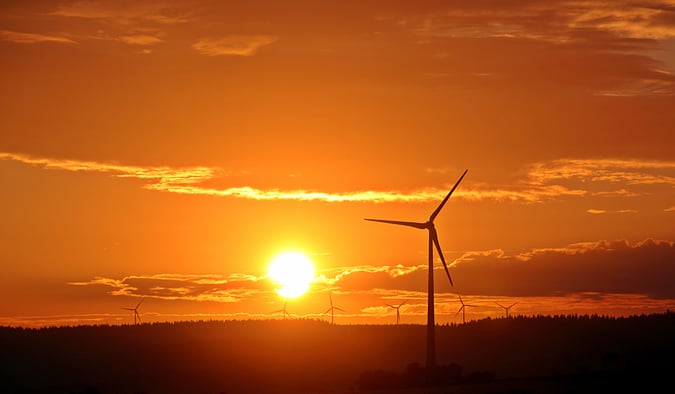As we mentioned last week, re-imagining a life and a world in the age of coronavirus presents a lot of unanswerable questions, yes, but also several opportunities. One those opportunities is the critical role clean energy and sustainability will play in reviving the economy and helping consumers adjust their behaviors and habits.
During the last significant economic recession, we saw firsthand how investment in the clean energy space created jobs and provided a jumpstart to a severely impacted economic climate. With the 2009 American Recovery and Reinvestment Act, President Obama made the largest single investment in clean energy in history, providing more than $90 billion in strategic clean energy investments and tax incentives to promote job creation and the deployment of low-carbon technologies. The investment created more than 80,000 jobs in the clean energy sector by the first quarter of 2010 alone, and raised the level of GDP by between 2 and 3 percent from late 2009 through mid-2011. By 2016, the White House Council of Economic Advisors reported that the Recovery Act clean energy-related programs supported roughly 900,000 job-years in innovative clean energy fields from 2009 to 2015.
And now, in 2020, renewable energy and the technology required to transition to a fully clean economy stand again at a precipice, primed for even greater scale adoption and a saving grace to a world trying to establish a new normal.

Here are five ways in which clean energy will help reshape and re-frame our world going forward:
1. It will help stimulate job growth: As in 2009, investments in renewable energy and clean energy technology now will pay off in dividends, first and foremost, when it comes to job creation. An April report from the International Renewable Energy Agency found that heavily investing in the industry could quadruple the number of jobs available in the sector to 42 million globally over the next 30 years.
And as we are still a long way off from a full-scale, fully adopted clean energy transition, the jobs created by investing here will be jobs that stick around for years to come.
Effective promotion and recruitment for these jobs will be a key to successfully growing the industry and fostering a sense of optimism around the opportunities presented.
2. By reducing pollution, it will improve the health of communities and may help decrease susceptibility to highly contagious respiratory diseases: In the post-coronavirus "new normal," effectively communicating the public health benefits of renewable energy adoption should be a top priority.
A 2020 study from the Harvard T.H. Chan School of Public Health found that even a tiny, single-unit increase in particle pollution levels in the years before the pandemic was associated with a 15% increase in the death rate from coronavirus. The study went on to note that if Manhattan had lowered its average particulate matter level by just a single unit, or one microgram per cubic meter, over the past 20 years, the borough would most likely have seen 248 fewer COVID-19 deaths by early April.
From the research that is available, we have learned the coronavirus is not necessarily a one-and-done disease and has a high-risk of becoming a seasonal, mutational virus strain much in the way of the flu virus. Reducing carbon emissions through the wide-scale adoption of clean, renewable energy would reduce air pollution, increasing the overall health and well-being of communities facing the greatest risk of contracting life-threatening, highly contagious respiratory diseases.
3. Clean energy will help us reevaluate life indoors and shape the way we think about day-to-day expenses. For the past several weeks we have all been spending a lot more time inside. Even as the country inches closer to recovery, we’ll continue to see more of the four walls of our homes as schools remain closed for the year, more offices shift to a work-from-home model, less travel happens and several other social distancing guidelines remain in place. The extended time inside has shifted the focus to how much energy we’re using (especially as residential energy costs rise due to more time at home), and tighter budgets in general have families thinking about ways they could be saving money.
That shift in focus could help prime renters and homeowners alike to be more open to adopting clean energy alternatives, especially those positioned as more environmentally friendly and cost-effective. While the focus may initially be on cheaper ways to heat and cool the home or cut down on overall energy consumption, thoughts of saving money could redirect attention to electric vehicle adoption.
Companies spanning the clean energy industry should be prepared to offer guidance for residents re-evaluating their energy bills. Making an effort now to proactively educate consumers on alternative heating and cooling options, community solar in’s and out’s, electric vehicle installation infrastructure and the benefits of residential energy storage will help everyone make the energy-saving adjustment that is right for them and good for the environment.
4. Clean energy will shape the way we do business. As individuals, coronavirus has shifted the way we interact. For businesses, coronavirus has already forced a shift in just about every facet of operations. Businesses that make it through the pandemic with their doors still open will undoubtedly still be facing harsh economic realities in order to stay solvent, and therefore will be tasked with reimagining their supply chain, the role they serve in society and, as with residential customers, the way that they use energy.Renewable energy and clean energy technology will be visited, and should be marketed, as potential fixes to make business more cost-effective and efficient:
- Solar and energy storage bundling options may seem more appealing as ways to reduce potential and even more costly (than pre-pandemic) system downtime caused by electricity outages.
- Fleet electrification may seem like a viable option to save money on fueling company vehicles and transporting goods necessary for meeting revenue goals while allowing businesses to redirect those savings elsewhere.
- Energy-efficient office appliances, while once overlooked, may become a higher priority.
- Workforce training opportunities to help build employee skills in new and emerging clean energy technologies may be viewed as a smart and proactive way to add value to current customers, attract new customers and in the face of an uncertain economic future, add a blanket of both job and business security.
- Ensure their workforce is equipped to navigate these changes and shifts in energy deployment and utilization.
- Work with communities, regulatory bodies and partners to ensure that a modern, flexible grid infrastructure is in place to adequately withstand large-scale clean energy adoption and the technology that comes along with it.
- Evaluate their current offerings to make sure they’re not only meeting the changing energy needs of their customers but doing so in a model that is accessible and affordable for customers struggling to make ends meet. That may mean optimizing their digital customer experience, or shifting messaging on social media to better align with the concerns of their customers. It could also mean shifting focus to energy storage, electric vehicle incentives, solar installation offers or community solar options and considering the opportunity to bundle solutions, lease infrastructure, or offer subscriptions where possible.
- Act as a guide for community members by proactively providing education on available energy-saving technologies and alternative energy solutions for a new and uncertain future.
As we look to a future where the unknowns far outweigh the certainties, we take comfort in knowing we all have the power to shape the new normal, whatever it may be. Clean energy, and the way brands' individual commitments, plans and solutions are communicated, will only help create even more opportunities to shape it. Need help navigating those opportunities? Get in touch today and start the conversation!
